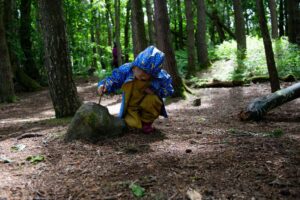For all ages, the past two years have at times been strange and hard.
While we are firmly landed in the dormant months, with their crisp-air, hard ground and bare trees, it can feel as if the woods are holding their breath for the big sigh and limb-shake of spring.
The everyday tasks of life can feel heavy. Waking up just slightly before you feel ready. Donning endless layers. The icy claw of the dustbin handle. The sun, though bright, reluctant to rise from a low droop in the sky.
So what can we do?
Mindfulness is a not-always-helpful blanket term used to describe many helpful things. I’m sure many of you already know the benefits of meditation, yoga and breathwork and perhaps you use these regularly in managing stress, soothing anxiety and bolstering confidence and self-esteem.
(Topically, there are also arguments to suggest incorporating some sort of mindfulness practice can boost the immune system https://www.mindful.org/train-brain-boost-immune-system/.)
For the early years, who live in the exhilarating but exhausting world of the immediate, the attention span may not be as long but the need is still there. It’s easy to forget that children of this age can feel stress and the burden of responsibility relative to them, and as such mindfulness tools can and should be adapted to meet their needs too.
The Secret Garden’s use of the Hand in Hand listening tools, (in particular Staylistening and Playlistening), support and allow the children to recognise and express their feelings in an unhurried, non-judgemental way, and are among its many valuable functions a concession to the power of mindfulness, and as such an appropriate introduction to it for this age group.
Helpful in delivering this support to the children is a basic understanding of the amygdala, the part of the brain located in the limbic system that detects stress and is linked to the prefrontal cortex, which governs emotional response.
Keeping the amygdala happy is enjoyable work. (And let’s also remember, child’s ‘play’ is actually highly important, exhausting and often complex, work.) Amygdala-soothing activities involve games, laughter, and social activity with people that are liked and trusted.
When a child is overly stressed, they can experience an ‘amygdala hijack.’ The limbic system fires up and cortisol and adrenaline start flowing freely to mitigate the danger. The flight, fight or freeze response kicks in.
(Not to be confused with the game ‘Fire, Flood or Freeze,’ which contrastingly is another excellent way to soothe the amygdala, as well as introducing children to the concept of ‘stillness’ in a way they find rewarding, and could perhaps plant the subliminal seed that mindful pause has its uses! This is an example of excellent ‘Playlistening.’)
In a hijack, the child’s reasoning brain shuts down. This type of situation will most likely sound familiar and it is every bit as unpleasant as it sounds for the child in question, who will need to express big feelings to clear the emotional ‘block’ the hijack will have caused. Staylistening is self-explanatory, staying and listening with minimal talking or interruption. Though gently encouraging the child to keep breathing deeply will keep them grounded and help to calm their nervous system.
Recognising triggers for this state is useful. If these can be removed or intercepted, and the child can be given the time, space and guidance to rebalance themselves, their recognition of and resilience to stress and other amygdala hijacks can build incrementally over time.
We know that pausing to breathe is a powerful tool. Deliberate, deep breaths which can be sighed, hissed or even roared out can be a huge help in challenging circumstances. If this sounds obvious that’s because it absolutely is. Isn’t it extraordinary how regularly we forget to do it? Even a brief period of concentrated breathing can truly ‘change your mind.’
If you can convince children to give it a try before their blood pressure starts to rise, they may discover this for themselves and add it to their toolkit of emotional management strategies. A more in-depth look at brain chemistry and a mindfulness success story for a little one: https://blissfulkids.com/mindfulness-and-the-brain-how-to-explain-it-to-children/.
Yoga is also excellent, and has the added child-friendly bonus of being a bit less boring as it involves some movement and interaction. Appropriately, Child’s Pose is one of the best for stress-relief and encouraging a couple of moments of stillness in comfort.
Adaptable for practice either alone, with a parent/carer or in a larger group, yoga is a good option for bonding with your child, or for the amygdala-soothing effect that group-based exercise has.
Some options for children’s yoga, depending on your preference: https://cosmickids.com/and https://gozen.com/8-yoga-poses-for-stress-relief-for-kids/
For purposes of balance, it is essential to acknowledge the importance of mindlessness for kids as well.
Those moments we witness when children are not being asked to think or to listen, and can experience the freedom of sailing to and fro on a swing; spinning a circle in a trance, or sinking their hands into a rich squidge of mud, (perhaps using it to idly redecorate a nearby friend/important document/car) minds delightfully and obviously unoccupied, are precious and worthy of protection.
I think perhaps the closest adults can get to emulating this happily brainless state is most likely in the supermarket queue, when we hover, amoeba-like, our gaze fixed on the middle distance, all cogent thought temporarily yet deliciously, lost…
By Mazz Brown, with many thanks to Claudia Ortiz, fellow Secret Garden practitioner, for her kind contribution.

